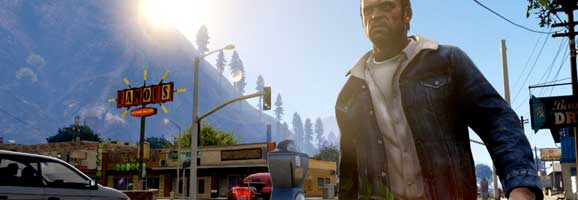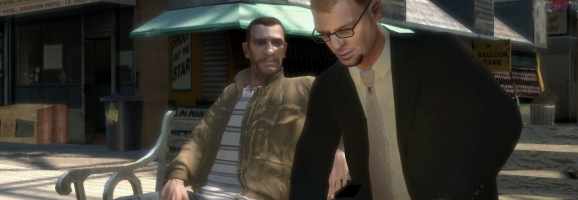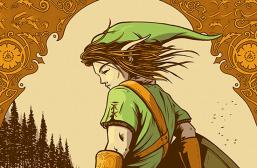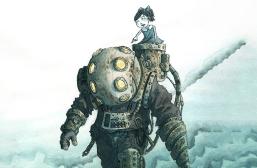Looking Ahead to GTA V: GTA IV and its Areas for Improvement

We may not think it but the Grand Theft Auto franchise has reached a crucial point, whereby the series can falter and hit crisis point or move into uncharted territory. It is a position which is symptomatic of the gaming industry itself and that is, as graphics and performance have improved rapidly over the years, do games attempt mimesis of real life? Or, do they abstract it and go beyond it? This is a question we must now ask of the GTA franchise simply because its raison d’être exists in its ability to extract from reality while at the same time removing itself, and the players, from it. GTA provides a virtual space for the player to inhabit whereby all our fantasies and frustrations can be enacted in-game, while at the same time inviting us to recognise and negotiate that which is taken from real life, namely American popular culture.
The problem is of course, as GTA aspires to mimic the visual, physical and emotional aspects of reality, it runs the risk of losing its foot in the hyper-real ‘cartoonish’ world for which it is so attached to. As this tension becomes more vital to solve in the upcoming release, we already saw the cracks appear in GTA IV, the results of which were numerous complaints, gripes and fallouts from fans and reviewers over GTA’s identity: what exactly was GTA trying to do, to be, as a game? Forget the myth of the ‘sandbox’ for a second. A sandbox game is still limited; it merely provides a better illusion of choice. Yes, the gamer is provided with more choice, but they are nonetheless choices brought upon us, and restricted by, that which the developers have made; we can only do what the game allows us to do. The idea of a ‘sandbox’ is a game in of itself, it says ‘let me present you a world, and let’s see what you can do with it’, it is a balance between immersion and imagination that requires both gamer and developer to work together. So, many gamers when presented with GTA, experiment with what they are allowed to do inside its world. With GTA IV, the objective response to this is rather simple: considerably less than previous GTA titles, especially GTA: San Andreas, the peak of the series’ creativity and interactivity, in creating its own cohesive world that was engaging and ‘full of life’.
Surface Realism
The rest of this article explores the tensions that were revealed in GTA IV over the franchise’s negotiation between the hyper-real and its increasing move towards realism. I just made the controversial claim that GTA: San Andreas was the most ‘full of life’ out of the entire series. It is controversial because one only has to look at GTA: IV’s physical aspects: its incorporation of ragdoll physics, its mock-indexical correspondences (i.e. light, shadows, reflections etc.) and its detailed recreation of a real life space and place, New York, to know that GTA IV seems more like a world, and one more identifiably ‘real’ than San Andreas. Or, one can look at the number of pedestrians, their movements and actions to know there was purpose to them and we all know a world seems less like a world if only you (i.e. the player) inhabit it. GTA IV therefore appears more animated than its predecessors. That is, at a glance.
GTA IV got by on what I call ‘surface realism’. It manages to replicate certain conditions of reality at the expense of interactivity. GTA IV’s details lies in its use of surfaces to provide the illusion of phenomenological experience for gamers, what we often call the presentation of a ‘living, breathing world’ which is merely our satisfaction with the idea that a game replicates the perceptions experienced by a human with our everyday lived reality. But if we begin to follow those pedestrians around with our character, Niko Bellic, (who we ‘live’ and perceive through) we find we cannot interact with them per se, besides do what we have always been able to do to them: murder them. The city looked impressive in its size and surfaces and its ability to evocate New York but how interactive was it? Was there much difference in environments? Could we go in many places (and so much of GTA’s potential lies in inhabiting spaces and making them our places)? This is one of the key complaints many had over GTA IV: being presented with a world but not experiencing the world. One of the key pleasures to sandbox gaming is rewarding players based on their level on interest; seek and you shall find. There was none of this to be found in GTA IV.

Too Much Realism?
GTA IV’s change in tone also proved to be too drastic for many players who were used to the acerbic satire and absurdity that became synonymous with the franchise. I’d argue that it was all still there albeit more subtle and more interlaced into the sombre storyline. However players did not like the idea of playing through the game, amassing large amounts of money only for it to not be reflected in the status or ascendency in Niko’s criminal career or collection of possessions. GTA IV presented the strange case of capitalism unfulfilled that was last seen in the franchise with GTA III. The frustration of this when compared to say, the trajectory of GTA: Vice City, where the player gets to amass a fortune of wealth, property and possessions felt rewarding and provided part of GTA’s key fantastical aspect: to be able to fulfil what many of its players cannot in reality. This lack of reward pleasure combined with GTA IV’s excessively downbeat story of hard-luck immigration was perhaps fit for the times more, in post-9/11 malaise, whereas Vice City reflected the 80s mantra of ‘greed is good’, something which is hard to espouse post-2008 financial crisis but it created a bitter pill for gamers to swallow. The idea for many of GTA is to escape reality by subverting it, or to make reality seem perverse and to normalise the perverse. GTA IV merely accentuated the everyday lived reality of blue-collar depression perhaps a little too much.
This tonal shift combined with the removal of key gameplay aspects and features frustrated fans who were accustomed to the intense interactive experience of GTA. People want role-play aspects so that the ultimate perverse fantasy of living as a hyper-criminal can be negotiated between the game’s presentation and our choices as a gamer (what the protagonist looks like, what his skills are, what he does and when etc.). Instead the ‘choices’ that we were given were solely narrative ones, which may have changed the protagonist, Niko’s, fate in some instances but nonetheless it was a fate foretold my pre-coded and scripted gameplay elements that we had no control over. Therefore the narrative and gameplay in many ways ended up becoming the precise opposite of what it claimed to be: more mathematical and mechanical. Either you choose ‘a’ or ‘b’ and ‘c’ or ‘d’ will occur. Fans felt short changed when the game lacked gameplay features that had been implemented into the franchise several years earlier (buying property, flying, dating, working out etc.). True, all of these were not unanimous in their popularity (i.e. dating) but hardly any were forced upon the player either. Instead we were given a kind of tabula rasa with GTA IV which went back to GTA III styled gameplay, as if the generational gap justified the removal of so many features of the franchise that we grew to love. And one only needs to look at GTA V to see that so many of the removed gameplay features are being restored; GTA V seems to be this generation’s San Andreas. It is a typical tactic used by developers to string fans along, and one that many gamers are getting wise to and tired of but GTA IV can be partially absolved from blame due to its long development time and presentation of a brand new engine for the franchise.
Becoming Less Like Life and More Like the Movies?
GTA V’s latest trailers tell us immediately that the game seems to aspire to the conditions of Hollywood, in that the trailer itself could have been taken straight from a Hollywood buddy-cop action movie. Is GTA now getting closer to replicating the conditions and pleasures of the movies? One could argue that it is instead a typical GTA move, in that a game set in L.A. is required to take on the form of its films; so much of what we know of L.A. is from cinema. That would be the postmodernist answer to what we have seen so far from GTA V. But though it is tempting to say that GTA is moving more towards realism, wouldn’t a modified response be that it is moving more towards cinematic realism? That its focus is to essentially have its players live inside of a crime movie? We can clearly see how Red Dead Redemption was Rockstar’s attempt to eulogise not the early 1900s as they were, but the early 1900s as we know it through the Western genre. The introduction of multiple protagonists in GTA V gives us moments of gameplay that are multiperspectival, something which cinema routinely does and no doubt this will be used to rank up the tension and suspense in the many heists that we are supposedly able to carry out in GTA V, a kind of tension and suspense we take for granted in cinema because of that editing discovery called cross-cutting.
Considering GTA is getting closer to replicating the cinematic medium as well further developing its own, the tension over its raison d’être develops and fascinates more. GTA has always taken from reality, and from other simulacra, making it a complex web of references to reality, or what we take to be reality. The fact that GTA is looking more like life, and GTA V’s L.A. looks decidedly more like L.A. than GTA San Andreas did, means the franchise is now approaching ever closer to its crossroads: does it take from reality or move further away from it? Or is the franchise proving that to be false dichotomy? It is this issue which is essential to the series’ enduring popularity and whether it can maintain it.
What do you think? Leave a comment.











The missions are dull and uninteresting and all involve either go kill this guy or… no that’s about it. The gunplay is some of the worst to ever be conceived with it’s lock-on and incredibly crappy AI. The graphics (bearing in mind that I played this on PS3) are awful. The characters will make you homicidal with their sheer idiocy. The only saving grace for this game is the driving. While it’s not as fun as some of the previous titles (San Andreas) it’s still hilarious. My take on it. Nice discussion btw!
Thanks for the comment per. It’s interesting that I disagree with almost every point you made haha. I agree the driving was perhaps the best gameplay aspect in the game but the shooting system was not too bad in my opinion. As for graphics, I thought they were stunning in 2008, and even if you think the graphics were poor, GTA’s forte has never been in creating the best looking game graphics. I agree, there is a monotony to the missions (and I think this goes back to the point I make about the move towards greater realism – which ultimately translates to less ‘unrealistic’ missions i.e. breaking into Area 51, or destroying building sites with toy helicopters etc.). In GTA IV it seemed the missions only were enjoyable if you were heavily invested into the story. Whereas in past GTA’s this did not need to be the case due to the outlandish gameplay elements (or, see Saints Row: poor storylines – but it’s not too much to its detriment).
Nice article.
I enjoyed gta 4,I loved the dlc additions too, the ballad of gay tony was perhaps the most fun of them. My problem with the upcoming gameis the multiple protagonist angle and how they have their own special qualities, they kind of did that with the dlcs… the result was that you had one character who sucked at motorbikes but could run fast… and one character who was great at riding bikes but his running speed was cripplingly slow…
I’d rather the protagonist was in the same vein as CJ from the original San Andreas, where you could improve on his every aspect (statswise)sadly I don’t think they will go down that route…
For me they need to get the fun aspect back into the game.
gta san andreas was the best gta.
Well I absolutely loved the plot of GTA IV. It was entertaining enough to be considered a movie or TV show. I really got a sense of connection with the characters. But when it came to the core gameplay of the story mode I found myself feeling a little empty Many missions seemed a little repetitive and there we’re few missions that really stood out. It seemed like I’d seen them already. And that’s because i pretty much had. Much of the game’s missions were pretty much recycled from the old games.
Nice article. I’m upset because I’m not going to be able to play the new one. I’m trading in my 360 soon so i can get more money for it (so i can be more likely to afford Xbox one when it comes out). I’m just hoping Rockstar makes a GTA V for the next-gen.
I believe it will be available for all platforms. Including next gen.
No word on next-gen release yet but rumours are that’s what the release delay from May to Sept was over. Same for the for P.C version, just rumours but it is likely to come out on all of them.. in time.
First World problems.
The thing that turns me off from Grand Theft Auto is that having a sophisticated story with emphatic characters is going to contradict or discourage player behavior in the sandbox of the game’s environments. Sandbox crime games are about having goofy fun in an open world and players creating their own objectives. Structuring the story to be dramatic, satirical, and emotional is going to conflict with the game’s mechanics, and actively contradict the silliness that attracts us to these kinds of games.
One series I think remedies this problem of ludonarrative dissonance is Saints Row. The game is so silly, filthy, and ridiculous that it promotes and encourages hyperviolent, goofy, fun. Either way, good article. In my opinion Rockstar’s games are highly overrated.
Interest perspective Kevin. I think this dichotomy between having a sophisticated narrative and aimless fun in an open world sandbox is a false one. I think they both can co-exist. GTA’s still trying to develop the form in that respect, which is why I feel it left Saint’s Row behind a long time ago. Really, Saints Row is a game in a similar vain to the original GTA. It doesn’t hold my interest in the sense that there’s nothing to pull me through in terms of progression because it is fun for fun’s sake. GTA benefits much better as a sandbox game due to cognitive mapping (which IMO can only work if there is a narrative element interesting enough to go along with the customisation/open world aspects).
true, and to that extent, I’m interested to see if they can do innovative things with this next sequel that solve that problem of dissonance. But personally, I think GTA’s crime dramas would work much better as a RPG in the vein of Mass Effect, since the narrative would coincide better with the mechanics.
Nonetheless, I remain more excited for Saints Row 4 simply because of superpowers.
GTA V is one of the best games I have ever played! I don’t believe the extreme realism takes anything away from the game’s credibility, it only adds to it by poking fun at the American dream. I haven’t played GTA IV, but San Andreas is also incredible.
Very informative review and thanks for the salute to San Andreas! I ruined my kid’s Playstation, I was so addicted to it. He got me my own game and console for my birthday and I ruined them too! When GTA IV and V came out, I was allowed maybe 10 minutes on #V and that was it–he could see the addiction! Lucky for him, it was no San Andreas, despite the awesome graphics. And as someone else wrote, playing THREE people? Much too confusing! Give me CJ or Tommy Vercetti.